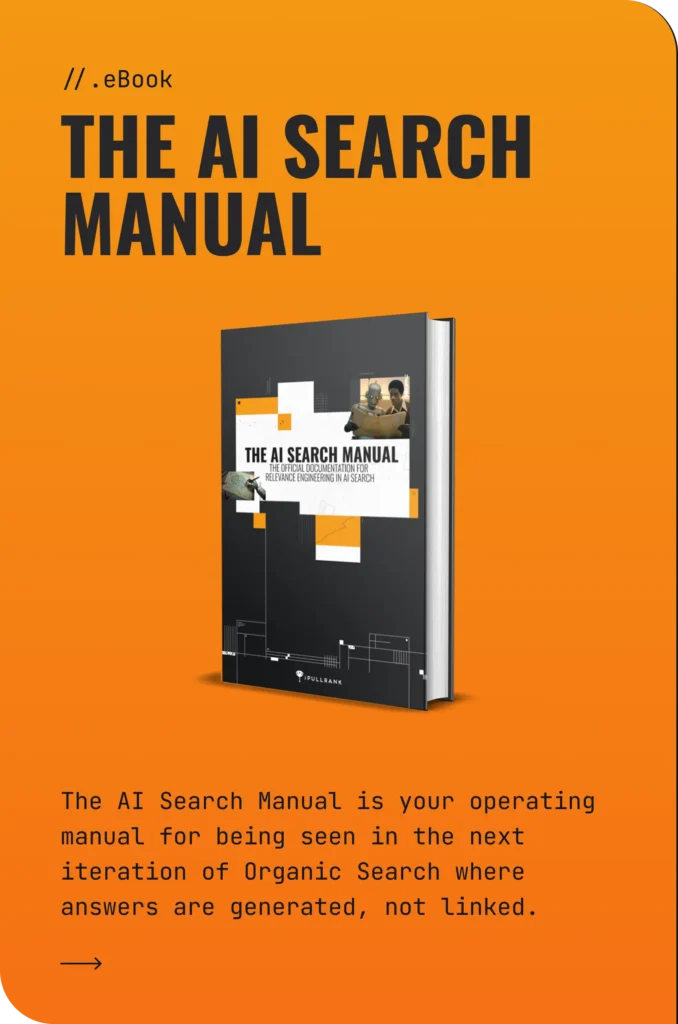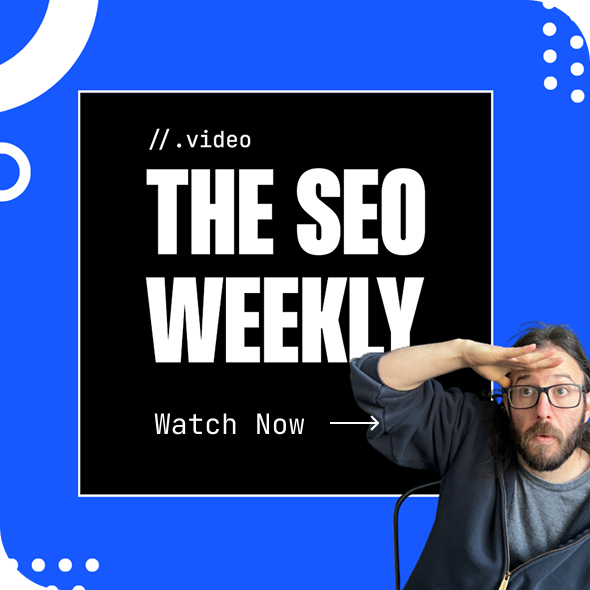“It depends.” That’s the common joke in the SEO industry. Every business exists within a different context. News SEO, eCommerce, Video, Local – they all have different nuances that impact the strategies and tactics that impact organic search visibility.
If SEO were a world map, Day 3 of SEO Week was international. And that felt appropriate since we had speakers from all over the world.
They were ready to explore not just how SEO works, but how it lives, evolves, and connects with the broader digital world.
This wasn’t just another day of slide decks and new chairs (iykyk). It was a deep dive into the interconnected web of content, code, creativity, and community that powers modern search, and the people who make it all go.

From technical SEOs and content strategists to data nerds and AI tinkerers, Day 3 felt like a celebration of every corner of the SEO ecosystem. And whether you were soaking up advanced testing insights, geeking out on search UX, or furiously scribbling takeaways on Reddit’s rising SERP dominance, the vibe was full-throttle.
But let’s be honest: we weren’t just there for the search talk. When the sessions wrapped, the crowd filed out not to go home, but to keep the momentum going at the Algorhythms Afterparty – a perfect blend of DJs, Busta Rhymes, drinks, and data-fueled dancing. SEO peeps by day, party pros by night.
From bold new strategies to late-night celebrations, Day 3 was peak SEO Week: smart, collaborative, fun as hell, and totally unforgettable. Let’s get into the highlights.
Jump to the speakers
Download all of the decks from our SEO Week day three speakers
The State of eCommerce SEO: How to Win in Today's Products SERPs

Aleyda Solis, international SEO consultant and founder of Orainti, offered a sharp look at e-commerce SEO in 2025, highlighting how Google’s SERPs now resemble rich product listings filled with visual features like product panels, Reddit threads, and YouTube reviews, fueling more zero-click searches and boosting user-generated content.
Still, she emphasized SEO’s critical role in growth, urging brands to optimize PDPs, create authoritative content, and monitor shifting SERP trends. Top tactics include using AI for content and structured data at scale, integrating with Google Merchant Center, and avoiding JavaScript rendering issues. Her core message: test often, align with the full customer journey, and embrace AI to stay competitive.

"It’s time to double down on your PDP’s optimization efforts to maximize not only the SER visibility but also to be ready for the next wave of AI integration that will happen very likely at the bottom of the funnel…The conversion journey will be changed drastically and the user will go directly to the PDP.”
- Aleyda Solis
Key points
- Google SERPs Have Become Product-Focused Ecosystems: Google’s search results have evolved into immersive product listing experiences, mimicking retail platforms like Amazon. These enriched SERPs feature navigation elements, product knowledge panels, image packs, videos, and user-generated reviews, often reducing the visibility of traditional organic links. This shift demands that e-commerce SEO strategies prioritize optimized product detail pages (PDPs) with rich, engaging, and technically sound content to compete in an environment increasingly dominated by SER features and direct-buy pathways.
- Authenticity and UGC Dominate Visibility Trends: Organic results from forums, Reddit threads, and other user-generated content are on the rise, displacing conventional retailers and general publications. This indicates a consumer preference for genuine, firsthand insights. To stay competitive, brands must invest in diverse content formats – like expert commentary, visual reviews, and community-driven discussions – that build trust and authority while aligning with user search intent.
- AI Adoption is Essential for Scalable SEO Execution: With growing complexity in SERPs and mounting implementation challenges, e-commerce SEOs are turning to AI-powered tools for automating content creation, internal linking, structured data deployment, and keyword targeting. These tools are crucial for overcoming resource constraints and accelerating rollout of SEO improvements. Strategic integration of AI not only boosts productivity but also helps future-proof SEO strategies in an increasingly competitive digital landscape.
- Technical SEO and Structured Data Are Crucial for Feature Visibility: As SERP features become more central to capturing clicks, robust technical SEO foundations are critical. Reliance on client-side JavaScript can hinder indexability and feature eligibility. Ensuring server-side rendering or pre-rendering, particularly for PDPs, along with precise structured data implementation, enables e-commerce pages to appear in high-visibility elements like product packs, image thumbnails, and rich snippets, driving discoverability and conversions.
- Zero-Click Searches Are Growing: Optimize for SERP Engagement: While the rise in zero-click searches is modest, it reflects a growing trend of users satisfying their intent directly on the search results page. E-commerce brands must shift focus from just ranking to earning engagement within SERPs, by optimizing for featured snippets, image packs, review aggregations, and other interactive modules. Success lies in providing value without relying solely on click-throughs.
- Ongoing Monitoring and Testing Drive Informed SEO Strategies: Real-time tracking of SER feature evolution, pixel-level visibility, and user click behavior is now essential for SEO success. Leveraging tools like SimilarWeb, Advanced Web Ranking, and SEO Testing enables practitioners to detect shifts, validate tactics through controlled experiments, and make data-backed decisions. A/B testing and split tests help secure internal buy-in and refine strategies based on measurable impact, not assumptions.
- Holistic SEO Must Span the Entire Customer Journey: Effective e-commerce SEO integrates brand-building, informational content, and high-converting product pages into a unified journey. From inspiration and education to purchase readiness, each stage must be supported with tailored content and seamless internal linking. This alignment not only supports greater visibility across diverse query types but also boosts customer trust, drives qualified traffic, and ultimately enhances revenue performance in an increasingly competitive search landscape.
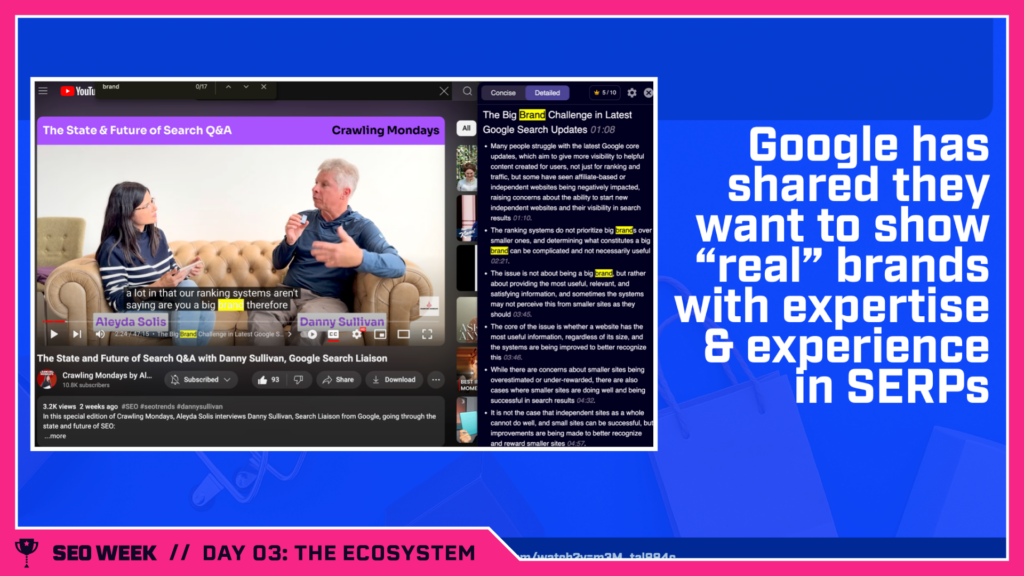
Important Takeaway
To succeed in 2025, e-commerce SEO must prioritize optimized PDPs, AI-powered scalability, and authentic content that aligns with Google’s product-rich SERPs. Focus on visibility within features, not just rankings, and adopt a holistic, data-driven approach that spans the entire customer journey.
Mini Glossary
- PDP (Product Detail Page): A webpage that provides detailed information about a specific product, critical for SEO visibility and conversions in modern SERPs.
- Zero-Click Search: A search where users find the information they need directly on the SERP without clicking through to a website.
- Structured Data: Code that helps search engines understand page content, enabling eligibility for rich results like product packs and review snippets.
- Holistic SEO: A comprehensive strategy that integrates technical SEO, content creation, and user experience across all stages of the customer journey.
All the Wrong Tech for All the Right Reasons

Farrah Bostic, founder and chief strategist of The Difference Engine, explored how AI is reshaping brand strategy and market research. As tech increasingly mediates customer interactions, she warned marketers not to lose sight of real human insight.
While AI brings efficiencies like automation and synthetic personas, Farrah stressed it can’t replace direct conversations and deep understanding. She championed “quick strike research” – fast, people-focused insight gathering – and urged marketers to build human expertise and stay resilient through constant change.
“When we start to automate our understanding of other people, of behavior, of trends, of technologies, we actually lose the opportunity to know something nobody else knows. Anybody can ask ChatGPT that question, but if you don’t talk to real people, you’ll miss what only real humans can tell you.”
- Farrah Bostic
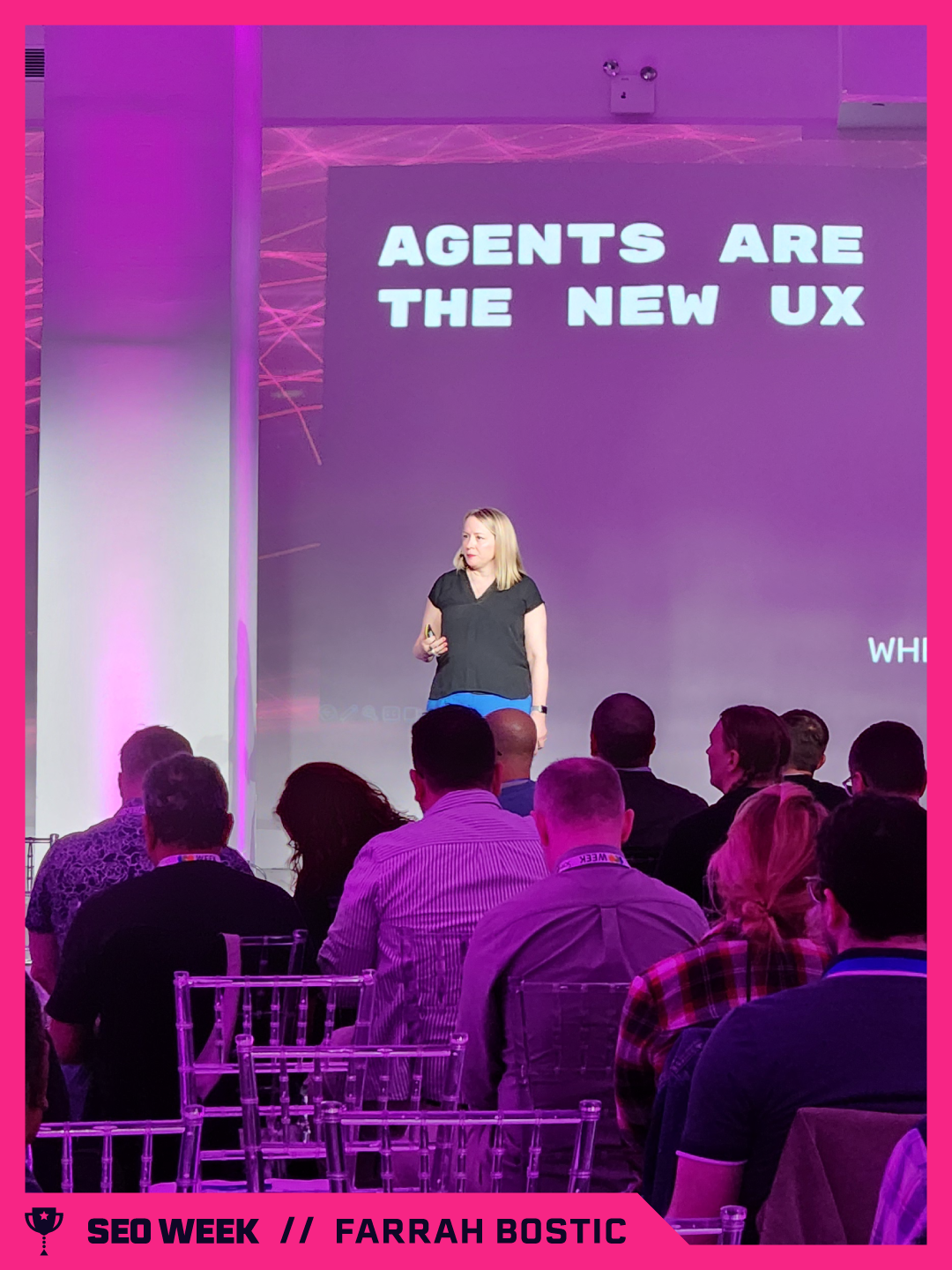
Key points
- AI Enhances Efficiency but Demands Human Oversight: While AI tools are increasingly embedded in marketing and research workflows – streamlining tasks like analysis, transcription, and persona creation – they lack the judgment, accountability, and contextual awareness required for strategic decision-making. Human expertise remains essential to interpret nuanced trends, validate AI outputs, and prevent misguided conclusions from synthetic or incomplete data.
- Brand Identity and Customer Insight Are Under Threat in a Mediated Landscape: As AI-powered interfaces increasingly mediate customer-brand interactions, brands are losing direct access to customer behavior, preferences, and feedback. This erosion, especially for brands selling through intermediaries like Amazon or Verizon, undermines trust, weakens brand recognition, and requires new methods, like qualitative research and stakeholder conversations, to bridge the gap.
- Quick Strike Research Re-centers Human Insight with Minimal Investment: Farrah advocates for “quick strike research” (targeted, low-cost, conversational engagements with internal teams, customers, and industry peers) as a practical alternative to complex research programs. This method surfaces real-world insights that AI cannot provide and empowers teams to reconnect with customer needs without heavy infrastructure or spend.
- The Marketing Talent Pipeline is at Risk Without Hands-On Learning: Overreliance on AI for basic marketing tasks threatens to hollow out junior roles that once served as training grounds. Without foundational skills in research, strategy, and analysis, future marketers may struggle to rise into senior positions or meaningfully engage with AI tools, contributing to a long-term decline in marketing competence and leadership.
- Strategic Leadership Must Stay Human in an Age of Automation: AI can assist with execution, but it cannot replace the responsibility or creativity involved in strategic planning. As Farrah notes, tools may suggest answers, but only experienced humans can interpret them wisely, adapt them to evolving realities, and ensure decisions align with business goals, ethics, and long-term vision.
- Resilience and Adaptability Are Imperative in Today’s Global Climate: The current era, marked by political isolation, economic uncertainty, and supply chain disruptions, requires marketers to extend their expertise, question assumptions, and remain agile. Farrah calls this “strategic resilience,” a mindset rooted in curiosity, human connection, and the ongoing development of new capabilities to thrive amid volatility.
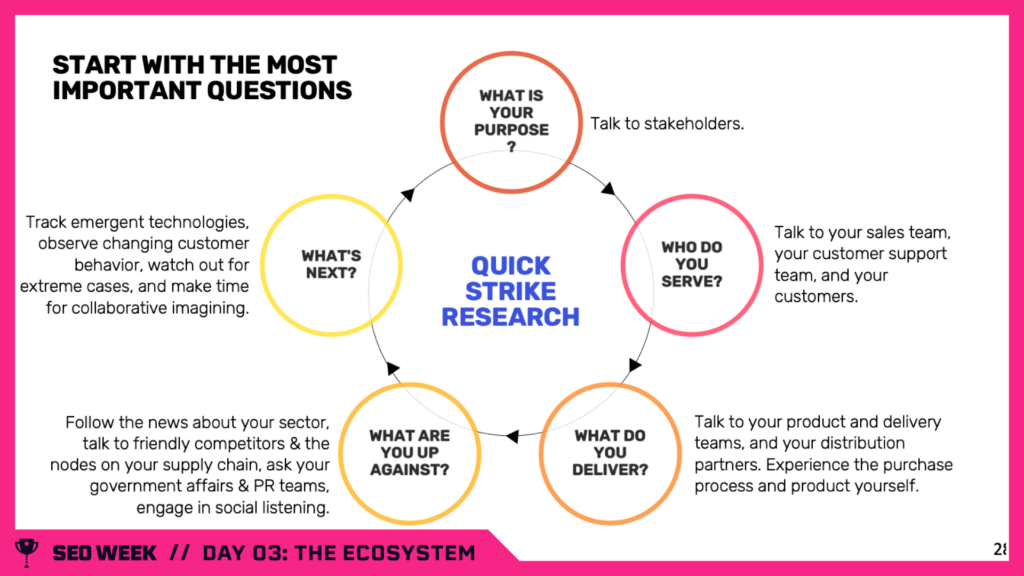
Important Takeaway
AI can support marketing, but human expertise is essential for insight, strategy, and trust in a rapidly changing, tech-mediated world.
Mini Glossary
- Quick Strike Research: A fast, low-cost research method involving brief interviews and internal conversations to gather actionable insights.
- Synthetic Personas: AI-generated fictional customer profiles used in place of real user research, often lacking authenticity.
- Strategic Resilience: The ability to adapt and expand expertise to navigate uncertainty, disruption, and change effectively.
- Downskilling: The reduction of workforce skills due to overreliance on automation, limiting the growth of future marketing leaders.
Proactive SEO Strategy: Replacing SEO Tools With AI Agents

Dale Bertrand, founder of Fire and Spark and a seasoned digital marketing strategist, shared how to futureproof SEO by integrating AI as a strategic assistant, not a replacement. He emphasized that while AI can automate and scale tasks, it still needs human expertise to train, refine, and interpret results.
At Fire and Spark, AI adoption evolved from basic prompts to advanced agents using tools like Google Analytics and Search Console via Model Context Protocol (MCP). These agents handle repetitive work, but human oversight is crucial for accuracy, strategy, and continuous improvement.
“Don’t get distracted by the quality of your SEO agent’s work—it’s going to fail. The value is in the training. If you train it, it’ll work like a dream. If you don’t, you won’t get any value from it."
- Dale Bertrand
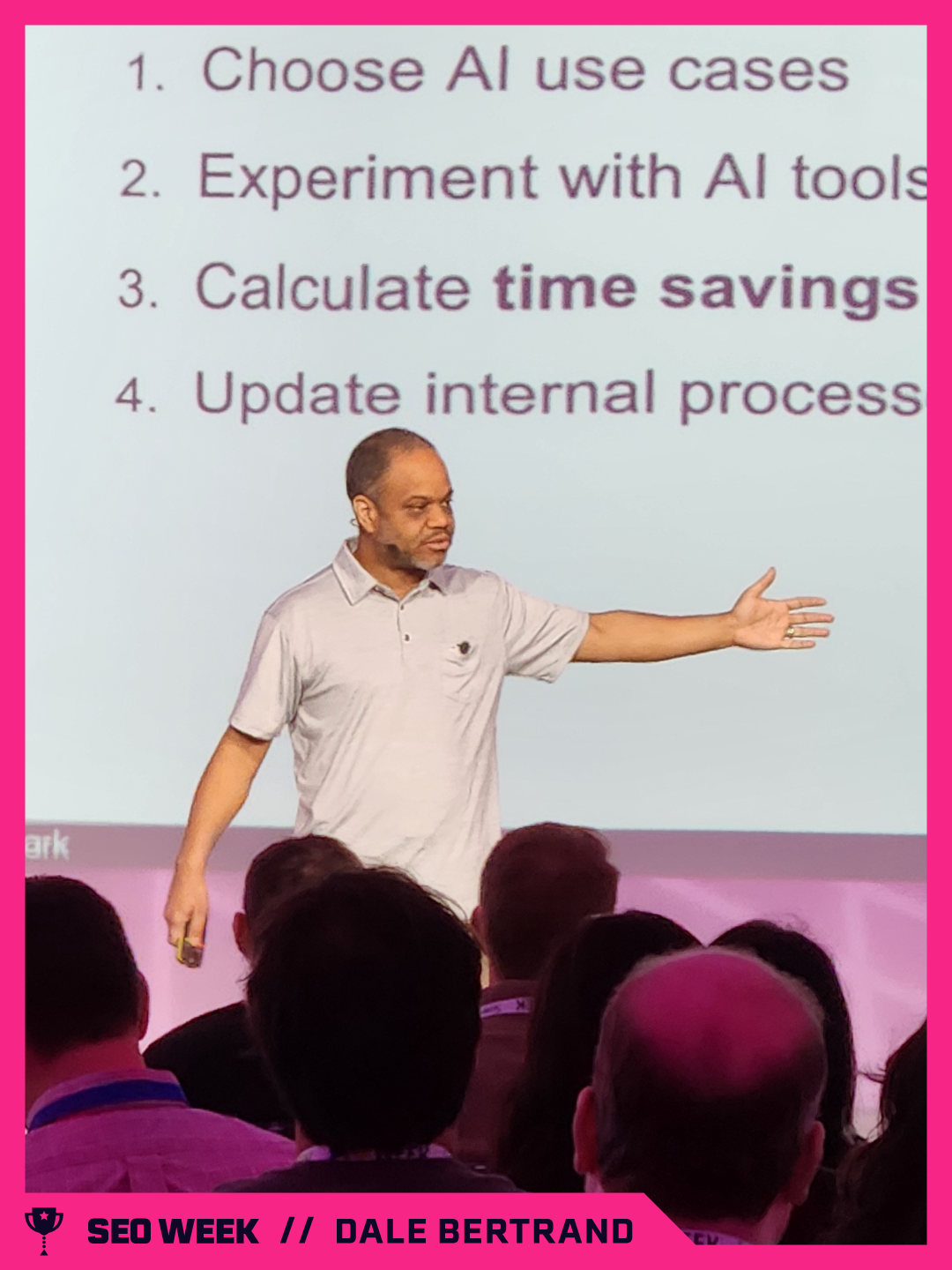
Key points
- AI Agents Enhance SEO Through Structure, Not Replacement: AI should serve as a collaborative partner, like a highly capable intern, rather than a full automation tool. By handling structured, repeatable SEO tasks such as audits and keyword analysis, AI agents free up human professionals to focus on creativity, strategy, and oversight. However, these agents require patient training and supervision to ensure relevance, accuracy, and business impact.
- Model Context Protocol (MCP) Unlocks Real-Time Data Access: A key advancement in AI’s application to SEO is the use of Model Context Protocol (MCP), which allows agents to directly interface with tools like Google Analytics and Search Console. This capability moves AI beyond static content generation, enabling it to pull live data, run customized reports, and perform in-depth analyses, dramatically increasing productivity and insight quality.
- Windsurf.ai Powers Scalable AI Integration for SEO Teams: Dale’s team utilizes Windsurf.ai, a purpose-built platform for developing and deploying AI agents. With native MCP integration, it supports the creation of agents capable of multi-step reasoning and tool usage. This infrastructure accelerates AI adoption, allowing teams to build workflows that amplify efficiency while maintaining control over strategic decision-making.
- AI Reshapes SEO Roles Toward Training, Oversight, and Innovation: As AI agents handle more of the tactical workload, the role of SEOs is evolving. Future SEO success will depend on skills in training AI, managing agent workflows, and iteratively refining outputs. Bertrand outlines a new SEO strategist profile, focused less on execution and more on AI orchestration, performance optimization, and strategic thinking.
- Productivity Gains Enable a Shift to High-Value Work: Fire and Spark’s adoption of AI resulted in a 30% productivity boost within the first year, with routine tasks delegated to AI agents. The time saved is reinvested in high-impact areas like content strategy, R&D, and innovation—proving that when properly implemented, AI augments human potential rather than diminishing it.

Important Takeaway
By focusing on the synergy between human expertise and AI capabilities, leveraging tool integrations through MCP, and embracing the iterative nature of AI training, SEOs can significantly enhance productivity and strategic impact in the evolving digital landscape.
Mini Glossary
- Structured Analysis: A repeatable, rules-based approach to evaluating SEO performance or opportunities, which AI agents can be trained to execute reliably.
- Model Context Protocol (MCP): A framework that allows AI agents to access and use third-party tools (e.g., Google Analytics, Search Console) to gather real-time data for decision-making.
- Tool Calling: The capability of large language models to invoke external tools (e.g., search engines, analytics APIs) to perform tasks beyond text generation.
- Sequential Thinking: A method used by AI agents to plan out each step of a task before executing it, improving the quality and accuracy of results.
YouTube Keyword Research 2.0

Phil Nottingham, Founder of Organic Video, emphasized that marketers often overlook YouTube’s massive search volume in favor of outdated text-based SEO tactics.
He introduced a YouTube-specific keyword strategy using “median monthly view velocity” to better gauge true viewer interest. While AI has a place in creative video formats, Phil stressed that authentic, human-driven content remains key to YouTube success.
“The entire world has gone video, and everyone in this room is worried about meta tags, blog posts, product pages…completely ignoring the main thing that you need to be doing, which is video.”
- Phil Nottingham
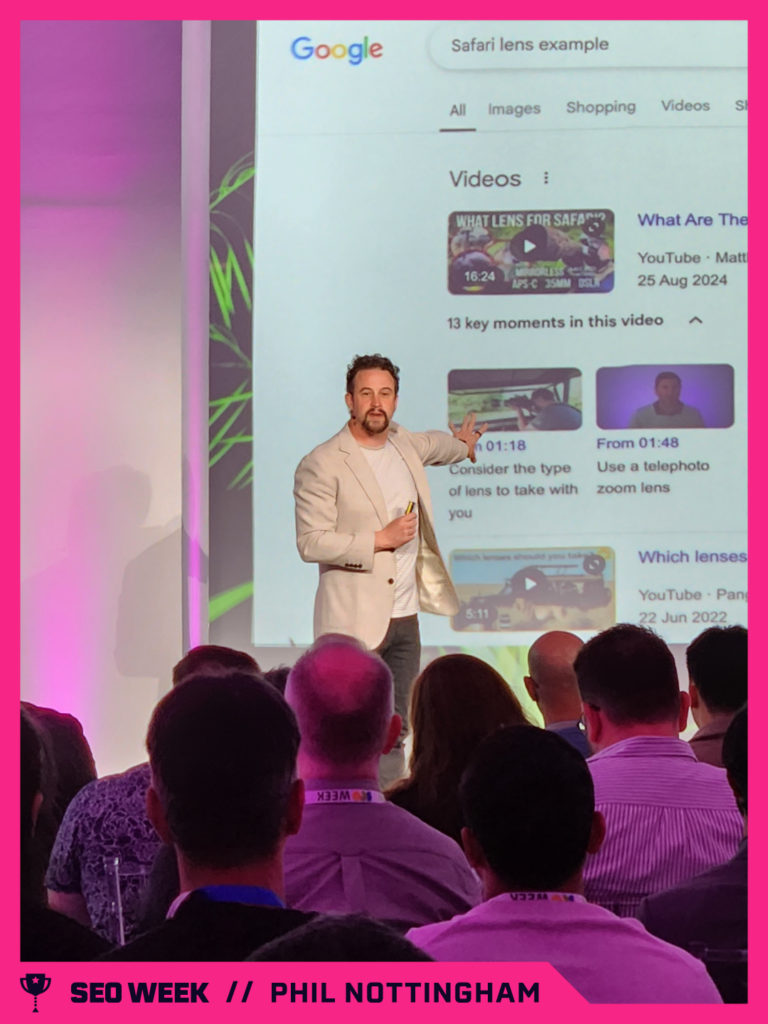
Key Points:
- YouTube Demands a Unique, Data-Driven SEO Approach: YouTube is a massive yet underutilized search engine, with around a billion daily searches. Traditional keyword research tools fall short due to the lack of accurate YouTube search volume data. Instead, marketers should rely on metrics like median monthly view velocity to gauge true content demand. Combined with competitive signals like channel subscriber counts, this provides a clearer picture of both opportunity and difficulty within any video niche.
- Strategic Video Production Hinges on Format, Length, and Competitive Insights: Successful YouTube content aligns closely with viewer expectations around video length and format. Categories like shorts (<1 minute), snacks (2–5 minutes), and features (10+ minutes) help guide optimal production choices. Aesthetic formats – static, dynamic, or artistic – further shape strategy. Scraping top-performing competitor content reveals what works, enabling marketers to model high-performing formats and identify underserved topics ripe for ranking.
- AI Supports Creativity, But Human Insight Drives Impact: Generative AI can assist with certain video formats, particularly artistic or abstract content, but it cannot replicate the intuition, emotion, or judgment of human creators. Camera-driven YouTube videos still require thoughtful storytelling, visual composition, and brand-aligned messaging – areas where human creativity remains irreplaceable despite growing AI assistance.
- Automation Makes Advanced YouTube SEO Accessible: Phil introduced a free tool to reduce barriers; it automates YouTube keyword research and competitive analysis. This levels the playing field for marketers and content creators, empowering more teams to make informed, strategic decisions without needing advanced technical skills or expensive third-party platforms.
- Click-Through Rate (CTR) is the Linchpin of Video Performance: Even with strong content, YouTube success depends heavily on how compelling the thumbnail and title are. High CTR drives visibility and ranking, making it a critical performance lever. The speaker shared proven design and messaging templates based on extensive data, reinforcing that presentation is just as important as production when it comes to capturing viewer attention and earning clicks.

Important Takeaway
YouTube is a powerful but underused search engine – marketers must adopt video-specific keyword strategies and focus on view velocity, not traditional SEO tools, to succeed.
Mini Glossary
- Median Monthly View Velocity (MMVV): A custom metric that estimates video demand by dividing total views by the video’s age in months—used as a proxy for search interest on YouTube.
- Video Length Categories:
- Shorts: Videos under 3 minutes, designed for quick engagement.
- Snacks: Mid-length videos (3–15 minutes), suitable for tutorials and reviews.
- Features: Long-form videos over 15 minutes, typically in-depth content or storytelling.
- Aesthetic Video Formats:
- Static: Simple, direct presentation (e.g., talking head).
- Dynamic: Includes movement, edits, or multiple scenes.
- Artistic: Visually stylized or creatively edited content, often suited to ads or abstract storytelling.
Unlocking Google Discover Code - Analyzing 200+ Million Articles

John Shehata, CEO and founder of News Dash, highlighted Google Discover as a major traffic source – often surpassing Google Search – for content creators and publishers, thanks to its personalized, behavior-driven feed.
He urged publishers to focus on timely, high-ROI topics, use adjacent content to tap into trends, and craft curiosity-led headlines with strong visuals. Still, he warned: treat Discover as a bonus channel, not a long-term strategy.
“Google Discover is like a friend who shows up uninvited, sometimes daily, then vanishes without warning. You never know why they come or go."
- John Shehata
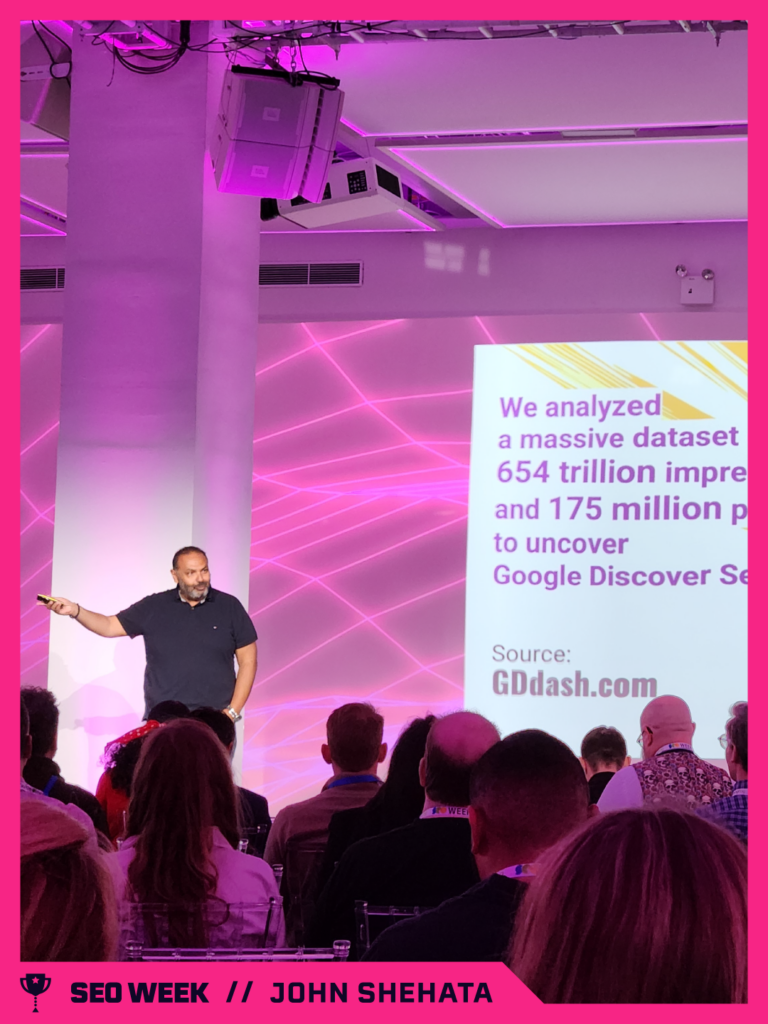
Key points
- Google Discover as a Dominant Traffic Source: Google Discover has surpassed Google Search in driving traffic for publishers and content creators, with higher CTRs and visibility but functions on a volatile, algorithmically driven system.
- Personalization and Content Matching Through Entities and Categories: At the core of Discover’s algorithm are entities (people, places, events) and content classifiers (topic categories). Google uses these to personalize 80% of user feeds based on behavior such as search history, app usage, and location data. To optimize for Discover, publishers should structure content around well-defined entities and relevant categories that match evolving user interests.
- Impressions as the Leading Success Metric: Unlike traditional SEO where clicks dominate, Discover success hinges on impressions; basically, how often Google chooses to show your content. High impression counts indicate alignment with algorithmic interests. Publishers should track impressions by category and entity to pinpoint high-ROI content themes and better inform editorial strategy.
- Capitalizing on Timeliness, Trends, and Adjacent Content: Discover rewards timely, trend-responsive content. Quick turnaround on trending topics and strategic use of “adjacent content” (related but not directly on-topic pieces) enable publishers to ride traffic waves. This approach helps capitalize on trends even outside their usual subject matter.
- The Power of Visual and Mobile-Optimized Content: Visuals play a major role in engagement, especially close-up images of people which foster connection and click-through. Alongside compelling thumbnails and longer, curiosity-driven titles, a mobile-friendly design is essential for optimal performance in Discover, which is primarily a mobile platform.
- Advanced Tactics and Optimization Techniques: Tactical optimizations, like refreshing URLs, A/B testing headlines, using OG titles, and tracking social velocity, can increase content visibility in Discover. While some techniques approach gray-hat territory, they demonstrate the need for agility and experimentation in content distribution.
- Scaling Success Through Syndication and Localization: Repurposing high-performing content across different languages and markets can amplify reach. Translating successful stories and aligning them with local interests and authority topics allows publishers to duplicate results globally while staying aligned with algorithmic preferences.
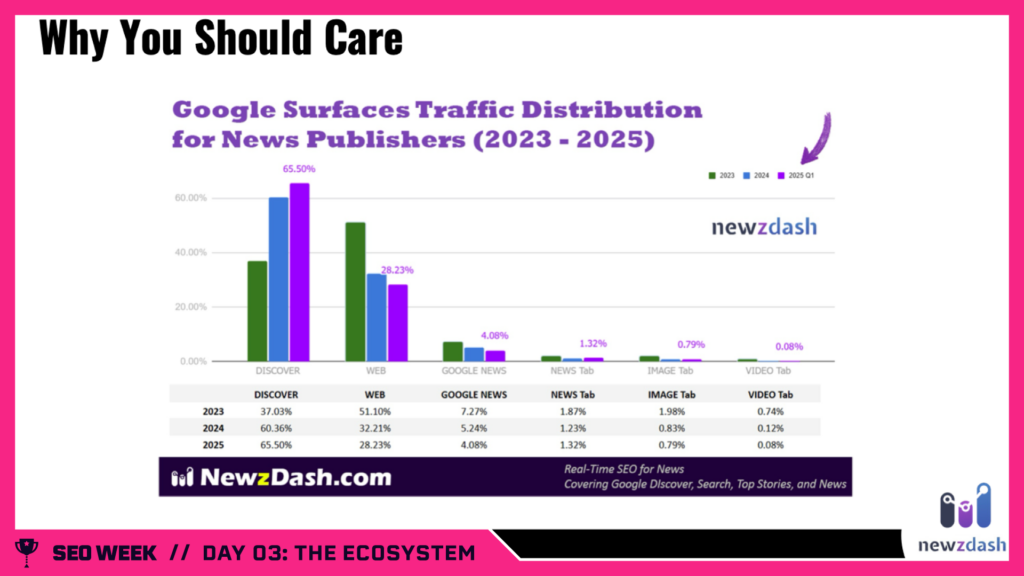
Important Takeaway
Google Discover has become an even more powerful traffic driver than traditional Search, but it’s highly volatile and personalized. To succeed, publishers must optimize for visibility (impressions), focus on high-ROI topics, leverage timely or adjacent trends, and pair compelling headlines with strong visuals.
Mini Glossary
- Entities: Real-world people, places, events, or organizations identified in your content, core to Google Discover’s personalization; matching entities to user interests helps surface content in the feed.
- Content Classifiers (Categories): Broad topical groupings (e.g., sports, entertainment, finance) assigned to content, used by Google to understand what your content is about and align it with user interest profiles.
- OG Title (Open Graph Title): A title tag specifically used for sharing on social platforms; Google may use them in Discover instead of the default headline as testing variations here can impact visibility.
- URL Refreshing: Republishing or slightly modifying an article to generate a new URL; a tactic to re-trigger content eligibility in Discover (especially for time-sensitive or news articles).
Diving into Deepseek 🐳 Generative Search Optimization

Crystal Carter, Head of SEO Communications at Wix, explored DeepSeek, a generative search tool using expert LLM modules. She explained how it breaks down complex queries and stressed the need for nuanced, multi-disciplinary content.
Crystal advised moving beyond outdated search intent models, embracing user-focused, AI-scaled content. She highlighted the rising impact of UGC, current events, and video transcripts, and urged brands to showcase their expertise to boost branded search visibility.
“Your brand should be the expert on your brand.”
- Crystal Carter
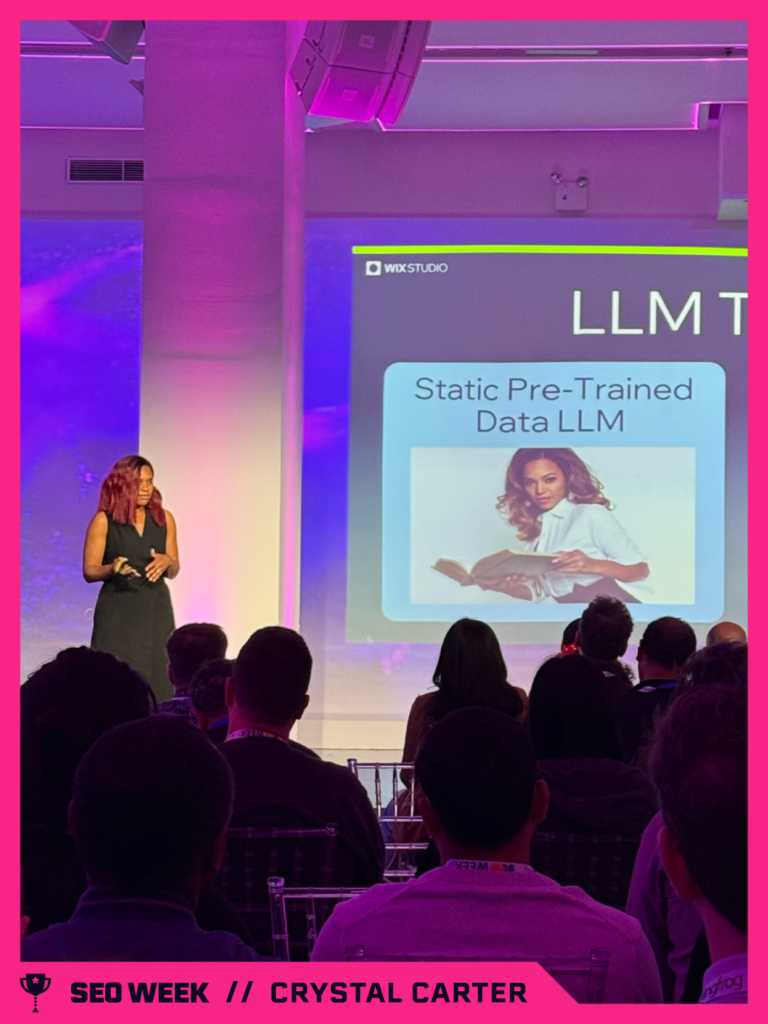
Key points
- DeepSeek’s Mixture of Experts Model is Reshaping AI Search Efficiency: DeepSeek uses a dynamic “mixture of experts” architecture that activates only the most relevant LLM modules to answer each query. This approach boosts accuracy and lowers processing costs, marking a major shift from static or retrieval-augmented models. Its success has influenced major platforms like ChatGPT and Perplexity, signaling broader adoption of this efficient, task-specific framework.
- Reasoning Models Drive a More Human-Like, Transparent Search Experience: These models break down queries logically, select specialized experts, and deliver answers with justifications and citations. With real-time web integration, websites become “experts” themselves – elevating the importance of current events, social media signals, and recency for visibility. Video content and transcripts also play a growing role, requiring a multimedia SEO strategy.
- Content Strategies Must Adapt to Complex, Multi-Disciplinary User Intent: Traditional SEO tactics are insufficient for AI-driven search. Instead, content must address nuanced “why” and “how” questions across disciplines, showing deep subject matter expertise. Brands should maintain a consistent, authoritative voice on their own domains, especially for branded queries, while using AI tools to scale high-quality, intent-driven content creation.
- Real-Time Visibility and Brand Authority Are Critical for LLM Success: With LLMs treating web content as sources, brands must regularly publish fresh, relevant content to compete. The integration of real-time search, user-generated content, and social signals gives an edge to agile publishers. Brands that own their narratives across formats and stay culturally current can improve their share of voice in AI-generated results – currently averaging around 20%.

Important Takeaway
To stay visible in AI-driven search, brands must create authoritative, real-time, and multi-format content that aligns with nuanced user intent, especially focusing on “why” and “how” questions across domains.
Mini Glossary
- Mixture of Experts (MoE): An AI architecture that routes queries to specific “expert” modules within a model, improving accuracy and efficiency by activating only relevant parts of the system.
- Content Classifiers: Broad topical categories used to label and organize content, helping AI match it to user queries and interests more effectively.
- Real-Time Search Integration: The capability of AI systems to pull live data from the internet, treating up-to-date web pages and social media as expert sources for answers.
- Share of Voice (SOV): A metric indicating how much visibility a brand has in search results or AI-generated content compared to competitors.
Enterprise-scale Ecommerce and Retail SEO Lessons From Thousands of Experiments

Will Critchlow, founder and CEO of Search Pilot, shared findings from thousands of enterprise SEO tests, revealing that some “SEO text” can hurt performance and title tag optimization is often underrated. He stressed the need for hypothesis-driven, data-backed strategies that tie SEO efforts to business results.
Will emphasized adapting to Google as the primary AI discovery channel and treating SEO as a performance channel. With rising paid search costs, he urged SEOs to build financially literate, outcome-focused models to justify budgets and drive measurable growth.
“For people to buy from you, the machines have to recommend you. But that’s been the case. That’s just Google."
- Will Critchlow
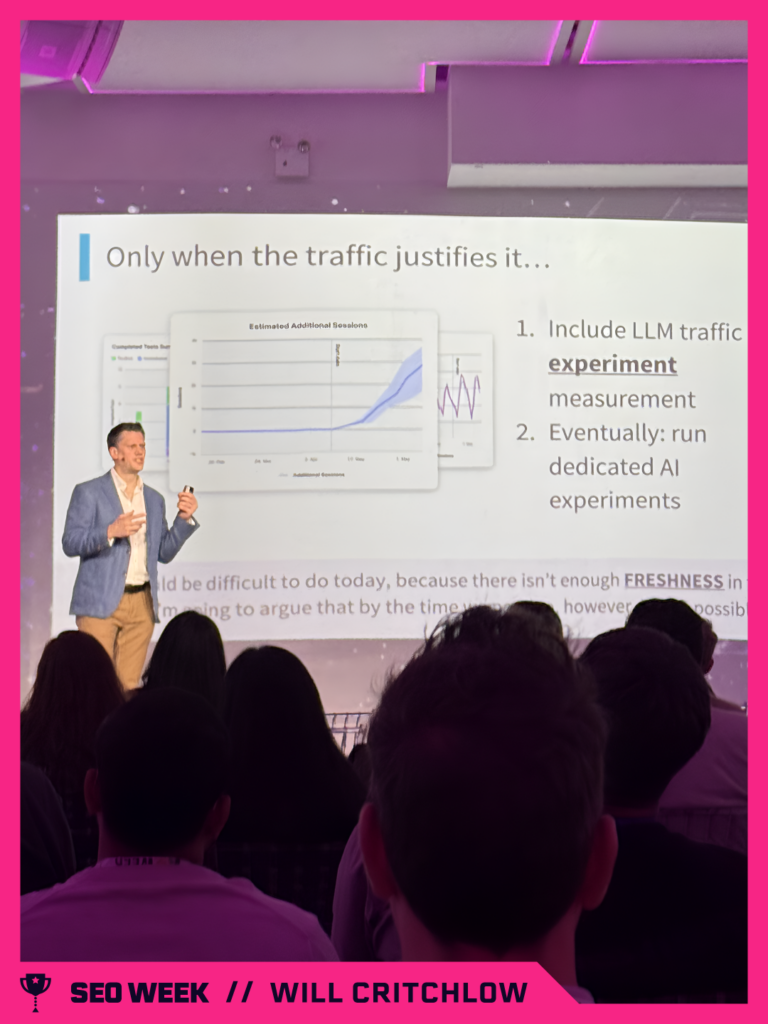
Key points
- From Crisis to Innovation: The Birth of SearchPilot: Will’s founding of SearchPilot was sparked by a challenging period at his previous company, which led to the creation of an SEO testing platform designed to provide concrete, data-backed proof of performance through thousands of controlled experiments – transforming SEO from intuition-driven to evidence-led.
- SEO Tactics Must Be Tested, Not Assumed: Years of experimentation have uncovered surprising truths: removing outdated or low-quality “SEO text” can actually improve traffic, and optimizing simple elements like title tags, often overlooked, can significantly boost both rankings and click-through rates. These findings highlight the need to critically reassess legacy SEO practices and focus on impactful, user-centered tactics.
- Google as the AI Discovery Engine…For Now: Despite the hype around generative AI, Google remains the dominant AI-powered discovery channel, especially for e-commerce. SEOs must optimize for Google’s evolving algorithms and AI-generated experiences, keeping traditional tactics relevant while preparing for future shifts in AI-driven discovery models.
- Budget Imbalance and Rising PPC Costs Create Opportunity: Will’s conversations with CFOs reveal escalating costs in paid search and an inefficient allocation of marketing spend – where organic search drives the majority of new customers but receives a fraction of the budget. This gap presents a strong business case for increasing SEO investment and shifting budget toward high-ROI, scalable strategies.
- Modeling SEO as a Performance Channel Is Crucial: SEO assets, like all assets, depreciate without regular maintenance, and the impact of optimization tests decays over time. Treating SEO as a performance channel means building financial models that account for these realities – tracking investment, testing velocity, hypothesis quality, and result sustainability – to align better with business expectations and secure larger, more consistent budgets.
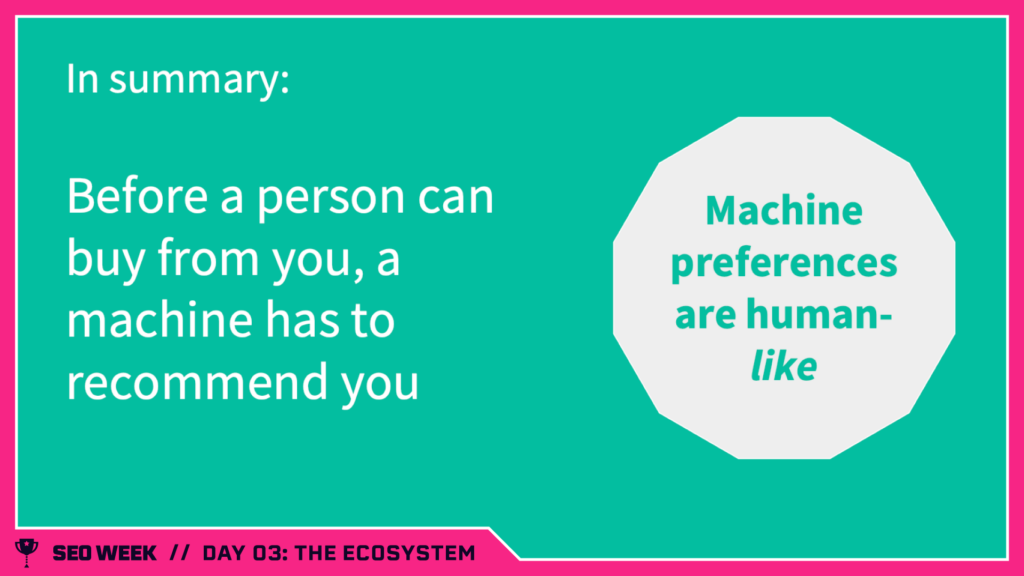
Important Takeaway
To secure greater investment and impact, SEO must be treated as a performance channel: grounded in continuous testing, realistic forecasting, and clear business value. Rather than just a set of best practices.
Mini Glossary
- SEO Depreciation: The concept that SEO gains and traffic naturally decline over time without ongoing investment and optimization.
- Test Result Decay: Recognition that even successful SEO changes lose effectiveness as algorithms, competitors, and user behavior evolve.
- Performance Channel: A marketing channel where inputs (like budget and effort) can be clearly linked to measurable outputs (like traffic or revenue), allowing for ROI-driven decision-making.
- PPC Overspend: When paid search (pay-per-click) advertising costs exceed expected or allocated budget, highlighting inefficiencies and potential misallocation compared to organic search performance.
The 3 Dimensions of Local Search

Greg Gifford, COO of Search Lab and a leading voice in local SEO, delivered a fun, insightful talk on the three pillars of local SEO: your website, Google Business Profile, and customer reviews. Despite the rise of AI, he emphasized that local SEO remains steady, and crucial, for businesses with in-person customers.
Rather than obsessing over technical tweaks, Greg urged a focus on clear, localized content that stands out. His message: be human, helpful, and authentic. Mastering the basics is still the best way to win in local search.
“You're not going to convert people the first time they come to your site; you've got to give people a reason to come back and convert later because they're not going to convert today."
- Greg Gifford
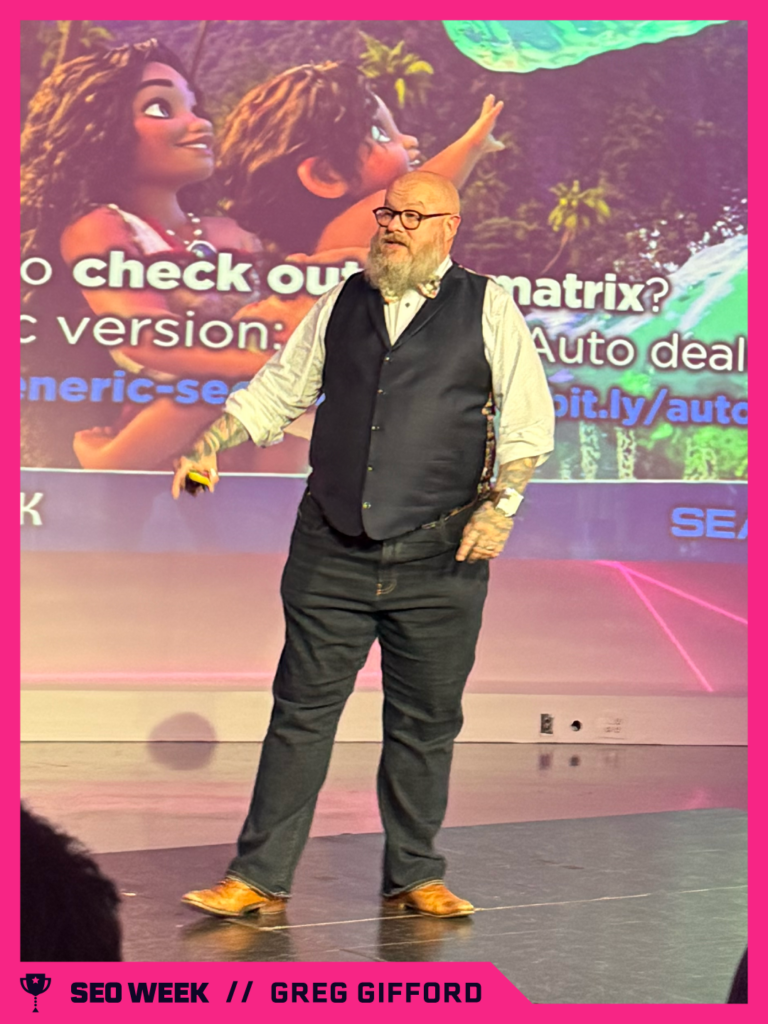
Key points
- Focus on the Three Core Dimensions of Local SEO: Your website, your Google Business Profile, and your customer reviews. These dimensions influence visibility in both the local pack and organic search results, and remain critically important, even as AI changes the broader search environment.
- Prioritize Pattern Detection Over Perfection: Search engines and AI systems operate on pattern recognition, not magic formulas. Rather than obsess over title tag length or stuffing in keywords, Greg recommends improving the clarity, relevance, and consistency of your digital presence so it fits recognizable patterns that search algorithms reward.
- Create Authentic, Localized, High-Gain Content: “Information gain” is the concept of offering more useful and specific information than competitors. Greg emphasized creating content that truly represents your business and local community. Tests like swapping business names or cities in your copy can reveal if your content is too generic. Conversational tone and natural language are key.
- Optimize and Protect Your Google Business Profile: Your Google Business Profile is often the first impression for searchers, especially for non-branded queries. Ensure every field is filled out accurately, upload high-quality images, choose the right category, and use schema markup correctly. Also, understand the reinstatement process thoroughly, because, as we all know, getting suspended can have long-lasting consequences.
- Leverage Reviews for Visibility and AI Readiness: Reviews carry increasing weight in local search and AI-generated content. Businesses should proactively request reviews, make submission easy, and respond thoughtfully to all feedback. Review length, helpful upvotes, and images improve visibility – so don’t just monitor reviews, strategically manage them.
- Use Tactical Audit Tools to Drive Measurable Impact: To identify gaps and improve efficiently, Greg shared his local SEO scoring matrix – a simple audit tool that evaluates a site’s performance across core dimensions. Paired with a Google Sheets cheat sheet that automates audit reporting, this system supports tactical improvements that boost results and build client trust.
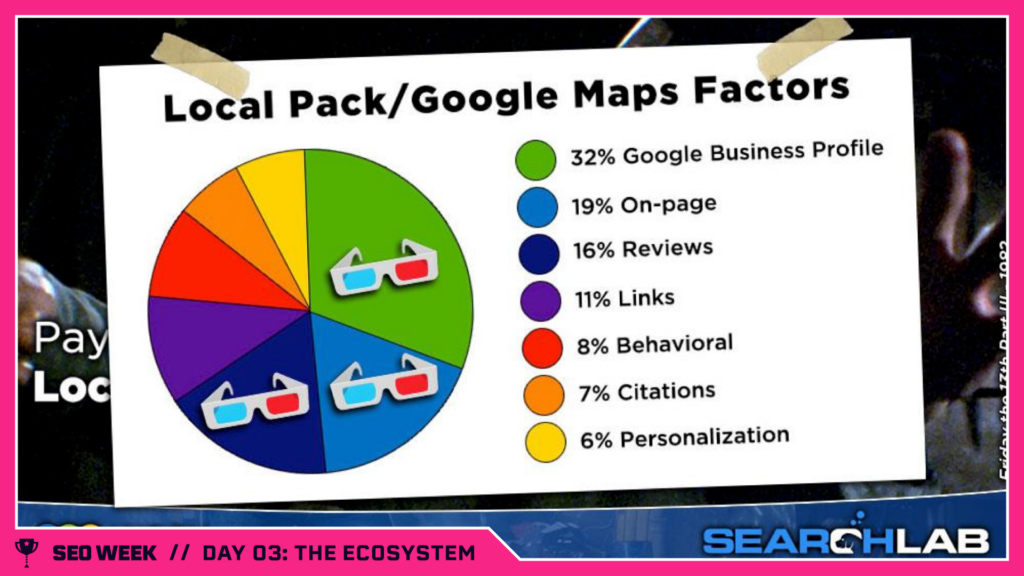
Important Takeaway
Local SEO success isn’t about technical perfection, it’s about improving recognizable patterns through authentic, localized content, optimized profiles, and well-managed reviews that help both users and search engines understand and trust your business.
Mini Glossary
- Review Sentiment: The emotional tone (positive, neutral, or negative) within customer reviews. It can influence rankings and AI recommendations.
- Local Content Silos: A site structure technique organizing localized content by topic and geography to improve search visibility in specific regions.
- Pre-Funnel Content: Informational content that targets potential customers early in their research phase, helping build brand awareness before they’re ready to buy.
- Local SEO Scoring Matrix: A tactical audit tool developed by Greg Gifford to assess local SEO performance across website optimization, links, Google Business Profile, and reviews.
Cultivating Momentum for Large SEO Projects

Ruth Burr Reedy, SEO, web analytics, and growth & demand generation specialist, delivered a sharp, no-nonsense talk on getting big SEO projects done in complex enterprise environments. She spotlighted how real progress comes from practical frameworks, strong communication, and navigating internal politics, not just good ideas.
Her key message: execution is tough not due to lack of strategy, but because of constraints like limited resources and misaligned incentives. Ruth offered smart, actionable advice on earning buy-in, mapping inputs to outcomes, and building the relationships that make SEO work stick.
“Execution is hard…the most important skill in SEO isn’t coding or analytics; it’s politics. You have to be able to get people to do stuff.”
- Ruth Burr Reedy
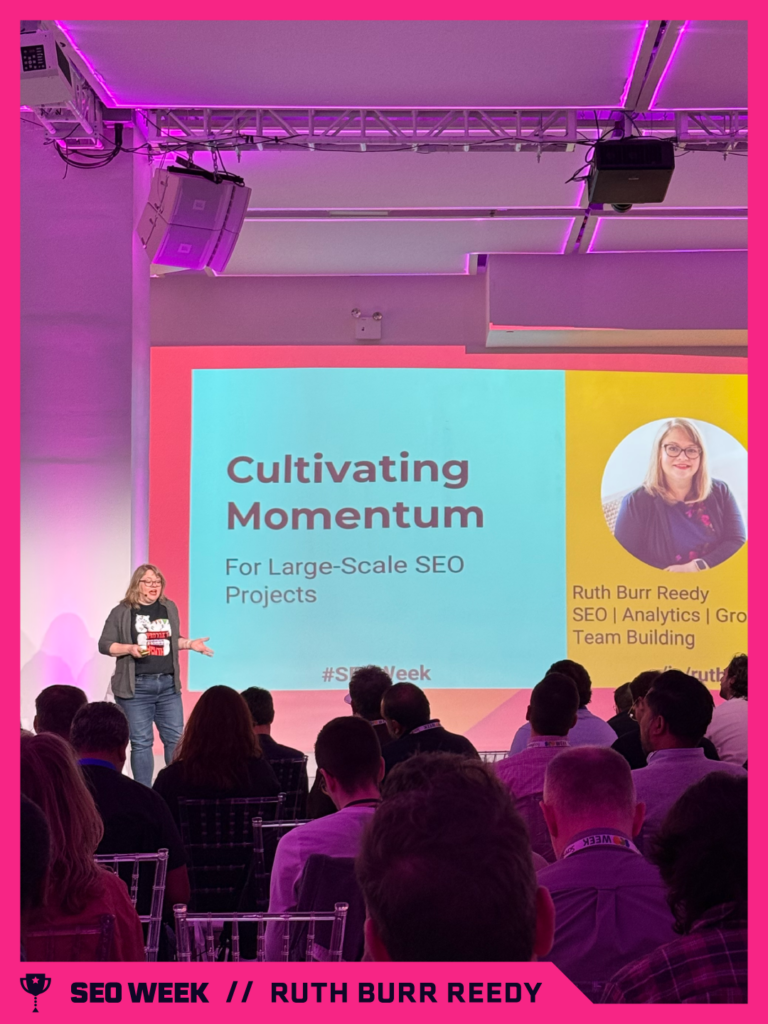
Key points
- Focus on Inputs You Control: Ruth emphasized the power of tracking and reporting on input metrics, actions within your control like content updates, schema implementation, or page optimizations, rather than solely output metrics like traffic or conversions. This Amazon-inspired framework allows SEOs to demonstrate consistent progress, maintain visibility, and justify continued support – even before results show up in analytics.
- Relationships Over Recommendations: Enterprise SEO is more about influence than instruction. Ruth argued that political skills like navigating internal orgs, understanding stakeholder incentives, and building preemptive goodwill are more valuable than technical expertise. Success comes from aligning your goals with others’ and communicating in a way that resonates with their metrics, not just your own.
- Make SEO Fit the Flow: Instead of creating new workflows for other teams, Ruth recommends embedding SEO into existing ones. Whether it’s customizing Jira templates or using automation tools like Zapier to monitor site changes, the goal is to reduce friction. The less you ask others to change their behavior, the more likely they are to support your work.
- Prioritize with an MVP Mindset: Not every recommendation needs to be implemented at once. Ruth advised focusing on a Minimum Viable Product (MVP) – the smallest set of high-impact changes likely to generate results. This approach lets you prove value early, reduce scope creep, and build a track record that can unlock more ambitious future phases.
- Report to Teach, Not Just to Show: Reporting shouldn’t be an afterthought; it should actively shape what stakeholders care about. By regularly surfacing input metrics and progress on execution, SEOs can reframe success beyond just rankings and revenue. This also helps flag blockers early and keep projects on track even when outputs lag.
- Speak Clearly, Act Decisively: SEOs often fall into the “it depends” trap. Ruth challenges us to own our expertise by offering specific, confident recommendations. Clarity not only builds trust, it respects colleagues’ time and accelerates action. Ambiguity, on the other hand, breeds delays and disconnects.
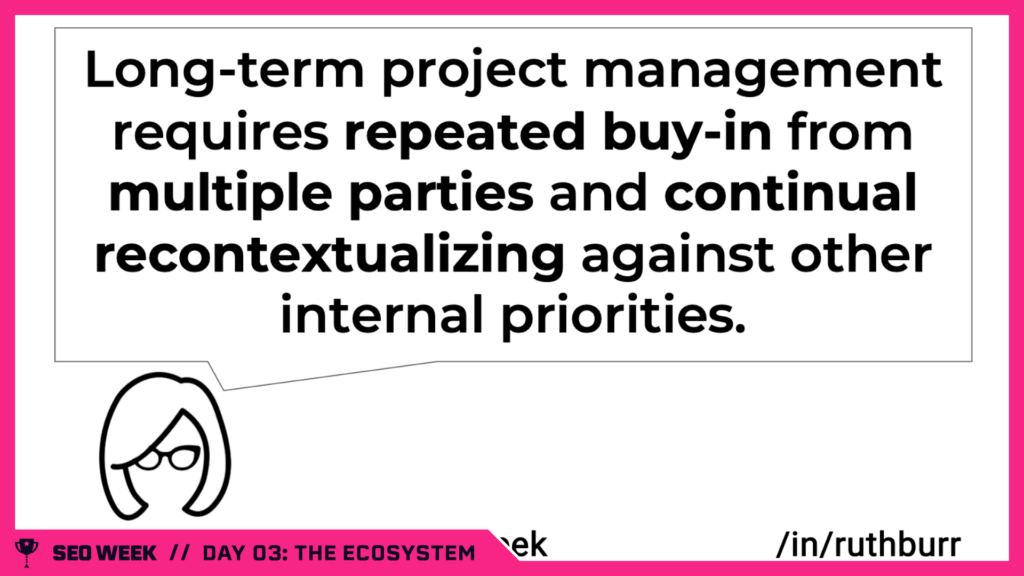
Important Takeaway
Ruth’s presentation wasn’t just a call to action, it was a practical guide for SEOs navigating the messy, human side of getting things done. Her emphasis on execution, empathy, and adaptability is a plus for anyone trying to move SEO from the strategy doc to the finish line.
Mini Glossary
Minimum Viable Product (MVP): The smallest, most effective version of an SEO initiative that can still produce measurable results. It allows for early wins and justifies further investment.
Workflow Integration: The practice of embedding SEO processes into existing team workflows (e.g., development sprints or content calendars) instead of asking others to adopt new systems. Increases cooperation and execution success.
Execution Reporting: The practice of tracking and sharing what work is in progress—not just end results. Helps sustain buy-in and illustrate momentum, especially for long-term projects.
It Depends (Trap): A common SEO phrase that signals ambiguity or complexity. Ruth encourages SEOs to replace this with clear, confident recommendations to inspire trust and faster action.
Search, AI & UGC: Navigating the Future of Google & Reddit’s Influence

Ross Simmonds, founder of Foundation and Distribution.ai, talked about how as Reddit continues to surge in influence, both as a hub for authentic user-generated content and a trusted data source for AI-powered search engines, marketers can’t afford to sit on the sidelines. With AI tools increasingly relying on Reddit to surface relevant, real-world insights, the platform is no longer just a niche forum – it’s a major player shaping search behavior and discovery.
Ross emphasized that the old playbook of traditional SEO won’t cut it here. Instead, marketers must embrace Reddit’s unique culture by engaging transparently, participating in good faith, and experimenting with data-backed strategies that prioritize real conversations over promotional noise.
By mastering Reddit’s ecosystem through observation, listening, and strategic participation, brands can tap into a goldmine of visibility, credibility, and consumer trust in the AI-first search era.
“Listen, lurk, and then make the leap."
- Ross Simmonds
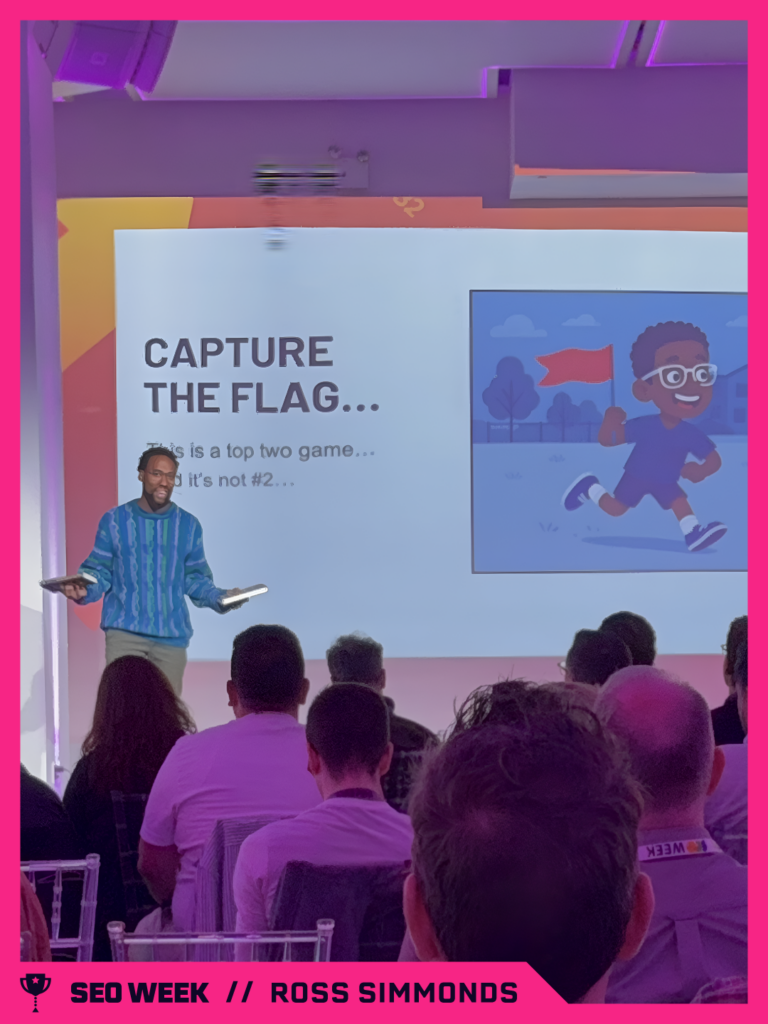
Key points
- Reddit’s Role in AI Search Is Exploding: Reddit content is increasingly used by LLMs to generate responses. This positions Reddit not just as a social forum, but as a critical node in the modern search ecosystem. Marketers who ignore Reddit risk losing visibility as AI-driven tools prioritize trustworthy, community-based insights over polished, keyword-stuffed SEO content.
- “Lurk, Listen, Leap” as a Winning Strategy: This approach encourages marketers to first immerse themselves silently in Reddit communities (“lurk”), then study conversations and patterns (“listen”), and finally engage in authentic, non-promotional ways (“leap”). This respectful, informed engagement minimizes the risk of backlash and increases credibility within Reddit’s discerning user base.
- User-Generated Content Outperforms Traditional SEO: Consumers have grown skeptical of highly optimized SEO articles and now often turn to Reddit for honest feedback and real-world reviews. This shift is especially evident in high-intent verticals like software, where Reddit threads are now outranking legacy review sites like Capterra and G2. Brands must learn to work with, not against, UGC trends.
- Tools Enhance Strategic Engagement: Reddit-native tools like Gummy Search and Reddit Answers allow brands to track sentiment, identify trends, and evaluate how their content is being surfaced. These tools make it easier to uncover opportunities for engagement, understand brand perception, and even benchmark against competitors.
- Building Infrastructure with Subreddits and Branded Accounts: Own your own subreddit and user handle before someone else does. This ownership enables moderation, branded content delivery, and direct community engagement. Examples from Sonos, Supernote, and SEMrush show how thoughtful participation can boost trust and brand visibility.
- Experiment with Ads, Remix Content, and Analyze Performance: Reddit allows for both organic and paid marketing efforts. With tools to analyze ad performance and subreddit engagement, brands can tailor campaigns to the right audiences. Rely on content remixing (e.g., adapting high-performing content for different regions or niches), installing Reddit’s pixel for retargeting, and using influencer relationships to amplify reach, all while remaining transparent and community-focused.
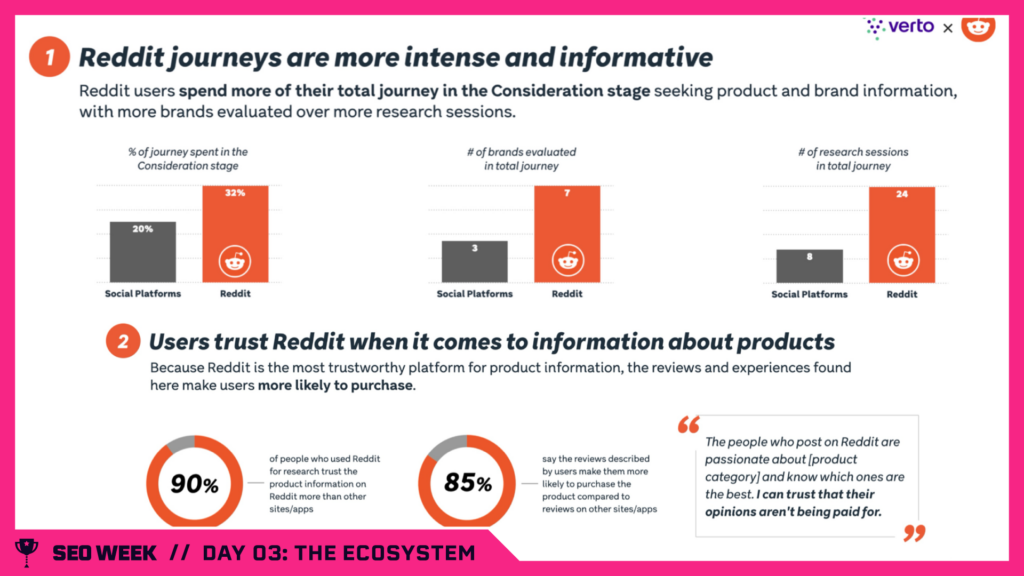
Important Takeaway
Reddit is no longer a fringe community, it’s a core part of the modern search and content landscape. By understanding and participating in its ecosystem with humility and strategy, brands can gain an edge in visibility, trust, and conversion in an increasingly AI-driven world.
Mini Glossary
- Subreddit: A community within Reddit centered around a specific topic. Brands can create their own subreddits (e.g., r/YourBrand) to foster direct engagement and control the narrative.
- Gummy Search: A tool that analyzes Reddit comments and sentiment for brand mentions across subreddits – ideal for market research and brand monitoring.
- Reddit Answers: An AI-powered feature within Reddit that uses its own user-generated content to answer questions, showcasing how Reddit is evolving as a search engine in its own right.
- Content Market Fit: The alignment between what a specific Reddit community finds valuable and the content you offer. Achieving this increases engagement and trust.
- Remarketing Pixel: A tracking code installed on a website that enables brands to target Reddit users who’ve previously visited their site with tailored ads.
ALGORHYTHMS AFTERPARTY
When we said Day 3 would end with a bang, we weren’t kidding. The Algorhythms Afterparty was a high-energy, unforgettable blowout headlined by none other than Busta Rhymes, who tore the roof off. But it wasn’t just Busta who brought the heat. The entire lineup brought the house down. DJ Lily Ray, yes, that Lily Ray, reminded everyone she dominates decks as effortlessly as she dominates rankings. Mic Icon King brought the lyrical heat; Tonedeff and PACKFM along with Mac Lethal and DJ Flip kept the night going.

After a day of deep dives into data and strategy, the SEO crowd let loose. Everyone was on their feet, rapping along and dancing like it was 2001. It wasn’t just an afterparty; it was a moment. The vibes? Immaculate. The energy? Electric. Algorhythms was the perfect mix of search brains and party chaos.
Stay Tuned - Next Week I’ll Review Day 4: The Future of SEO
As Day 3 of SEO Week wrapped, one thing was clear: the SEO ecosystem isn’t just evolving – it’s thriving. Packed with insight on AI, video, UGC, and platform-specific strategy, the day offered a clear-eyed look at the future of search. But beyond the frameworks and forecasts, it was a celebration of how we create, connect, and compete in a world where everything is search.
What really made Day 3 stand out? The people. The lobby convos, the shared Slack links, the lightbulb moments when someone said exactly what you’d been thinking. This was more than a conference, it was a community flex, full of curiosity and collaboration.
And then we danced. The Algorhythms Afterparty closed it all out in unforgettable fashion, and a crowd that brought the energy. If Day 3 proved anything, it’s that the heart of SEO isn’t just code or content, it’s people. Let’s keep building the ecosystem, together.

